Renault TWINGO 1995 Owner Manual
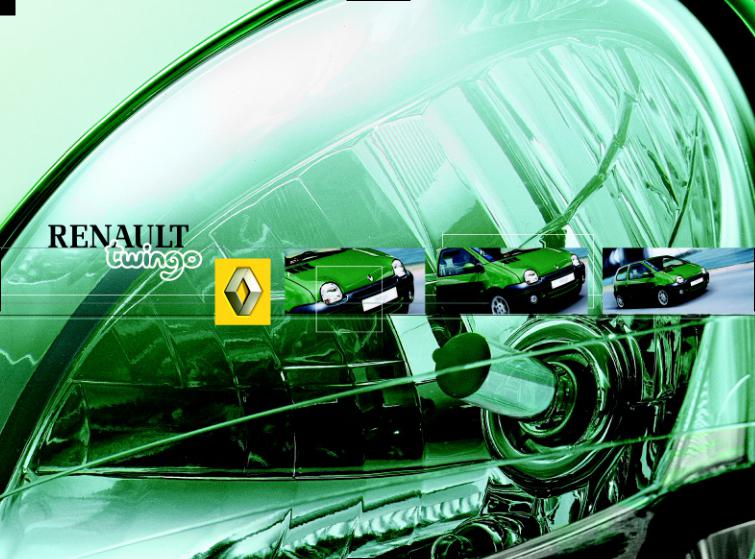

RENAULT recommends ELF
For all engines
For all engines
For all engines
Manual and Quickshift 5 gearbox Hydraulic actuation on Quickshift 5
ELF EXCELLIUM LDX 5W-40 |
ACEA A3 / B3 / B4 |
ELF ULTIMATE 5W-40 |
|
Premium performance and engine care |
|
|
|
ELF EVOLUTION SXR 5W-30 |
ACEA A5 / B5 |
ELF ELITE PREMIER PLUS 5W-30 |
ACEA A1 / B1 |
Fuel savings, engine care and protecting the environment |
|
|
|
ELF COMPETITION ST 10W-40 |
ACEA A3 / B3 |
ELF PREMIER PLUS 10W-40 |
ACEA A3 / B3 |
Other types of lubricants approved by RENAULT, for petrol or diesel engines |
|
|
|
TRANSELF TRJ 75W-80 |
API GL5 |
RENAULTMATIC D3 Syn |
DEXRON III |
RENAULT recommends ELF approved lubricants.
For top-ups or oil drain, we recommend you to use only original lubricants.
For further information, please contact your RENAULT dealer or go to www.lubricants.elf.com
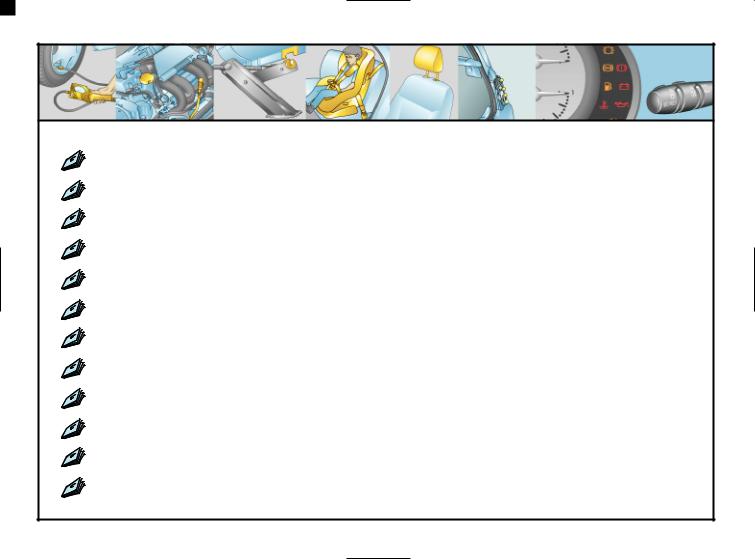
Brief overview
• Tyre pressures ......................................................................................................... |
|
0.04 |
• Adjusting the seats and driving position ............................................... |
1.09 |
1.13 |
• Child restraints .......................................................................................... |
1.21 |
1.31 |
• Warning lights ............................................................................................ |
1.36 1.38 |
|
• Horn and signals .................................................................................................... |
|
1.43 |
• De-icing/demisting ...................................................................................... |
1.45 - 3.04 |
|
• Running in, driving ................................................................................... |
2.02 2.18 |
|
• Heating/air conditioning ........................................................................... |
3.04 |
3.11 |
• Opening the bonnet ............................................................................................... |
|
4.02 |
• Levels (engine oil, windscreen washer, etc.) ......................................... |
4.03 |
4.09 |
• Emergency spare wheel ............................................................................ |
5.02 5.04 |
|
• Practical advice (replacing the bulbs, fuses, repairs, |
|
|
operating faults) ..................................................................................... |
5.02 |
5.32 |
0.02

C |
O |
N |
T |
E |
N |
T |
S |
|
|
|
|
|
|
|
Sections |
Getting to know your vehicle |
............................................................ |
|
|
1 |
|||
Driving |
............................................................................................................... |
|
|
|
|
|
2 |
Your comfort ................................................................................................. |
|
|
|
|
|
3 |
|
Maintenance .................................................................................................. |
|
|
|
|
|
4 |
|
Practical advice |
........................................................................................... |
|
|
|
|
5 |
|
Technical specifications |
........................................................................ |
|
|
|
6 |
||
Alphabetical index .................................................................................... |
|
|
|
|
7 |
||
0.03
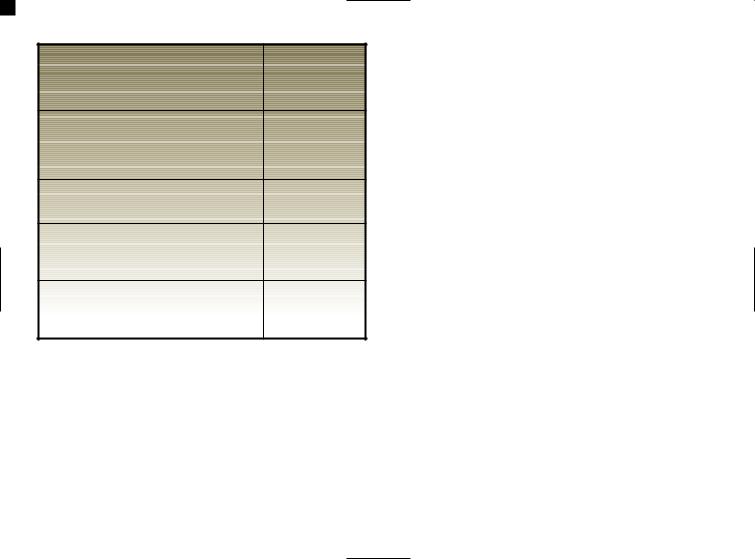
Tyre pressures when cold (in bar)
Normal use |
|
|
• Front |
2.1 |
|
• Rear |
2.0 |
|
Full load (1) |
|
|
• Front |
2.3 |
|
• Rear |
2.0 |
|
Emergency spare wheel |
2.3 |
|
Wheel sizes |
4.5 B 13 |
|
5.5 J 14 |
||
|
||
Tyre dimensions |
155/70 R 13 |
|
145/80 R 13 |
||
|
155/65 R 14 |
Tyre safety and use of chains
Refer to the information on tyres in section 5 for advice on tyre maintenance and, depending on the version, the use of chains.
(1)Special note concerning vehicles used at full load (maximum permissible all-up weight) and towing a trailer
The maximum speed must be limited to 60 mph (100 km/h) and the tyre pressure increased by 0.2 bar.
Refer to the information on “weights” in section 6 for more details.
0.04

Section 1: Getting to know your vehicle
Keys ................................................................................................................................................................... |
1.02 |
Radio frequency remote control ...................................................................................................................... |
1.03 |
Opening the doors ............................................................................................................................................ |
1.04 |
Locking the doors ............................................................................................................................................. |
1.05 |
Automatic locking of doors when driving (RAID) ........................................................................................ |
1.06 |
Engine immobiliser system ................................................................................................................... |
1.07 - 1.08 |
Front headrests ................................................................................................................................................. |
1.09 |
Rear headrests ................................................................................................................................................... |
1.10 |
Front seats ......................................................................................................................................................... |
1.11 |
Seat belts ................................................................................................................................................ |
1.12 - 1.13 |
Methods of restraint in addition to front seat belts ......................................................................... |
1.14 1.19 |
Seat belts (information) .................................................................................................................................... |
1.20 |
Child safety ........................................................................................................................................... |
1.21 1.31 |
Driving position ..................................................................................................................................... |
1.32 - 1.33 |
Trip computer and warning system ..................................................................................................... |
1.34 - 1.35 |
Instrument panel .................................................................................................................................. |
1.36 1.38 |
Rear-view mirrors ............................................................................................................................................. |
1.39 |
External lighting and signals ................................................................................................................ |
1.40 - 1.41 |
Electrical headlight beam adjustment ............................................................................................................. |
1.42 |
Audible and visible signals ............................................................................................................................. |
1.43 |
Windscreen and rear screen wash/wipe .............................................................................................. |
1.44 - 1.45 |
Fuel tank ........................................................................................................................................................... |
1.46 |
1.01
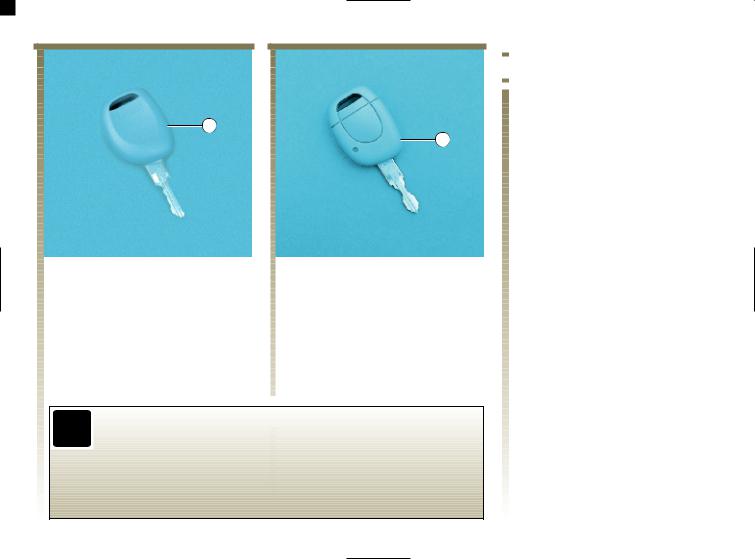
KEYS
1
1 Coded key for ignition, doors, luggage compartment and fuel filler flap.
2
2 Remote control locking unit, coded key for ignition, doors, luggage compartment and fuel filler flap.
 If a remote control has been lost or
If a remote control has been lost or
 if you need another set of keys or a
if you need another set of keys or a  remote control unit, contact your
remote control unit, contact your
 Renault Dealer as only he can help.
Renault Dealer as only he can help.
• If a remote control is replaced, it |
will be necessary to take the |
vehicle to your Renault Dealer |
because both the vehicle and the |
plip remote control are needed to |
initialize the system. |
• Make sure the batteries are always |
in good condition: they have a |
service life of approximately two |
years. |
Refer to section 5 of the driver's |
handbook for information on how to |
change the batteries. |
If there is a child (or animal) in the vehicle, never leave it
unattended with the key in the ignition. With the key in the ignition
he or she could start the engine or operate electrical equipment
such as the electric windows and there is a risk that the child may
be injured (by trapping his or her neck, arm, hand, etc.). Risk of serious
injury.
1.02

RADIO FREQUENCY REMOTE CONTROL
1
2
The remote control 1 locks and unlocks the doors.
It is supplied with power by a battery which has to be replaced when battery light 2 no longer comes on. (Refer to the information on radio frequency remote control batteries.)
Locking/unlocking the doors
Press the remote control for approximately one second to lock or unlock the doors. (Indicator light 2 will come on.)
The hazard warning lights flash twice to indicate that the doors have been locked.
The hazard warning lights flash once to indicate that the doors have been unlocked.
Note: If an opening element (a door or a luggage compartment lid) is open or not properly closed, the hazard warning lights will not flash.
The range within which the remote control will operate
This varies according to the environment: therefore take care when handling the remote control that you do not inadvertently lock or unlock the doors.
Note: On certain vehicles, if a door is not opened within approximately 30 seconds of unlocking using the remote control, the doors will automatically lock again.
Interference
Interference may be caused to the operation of the remote control by factors in the immediate vicinity (external installations or the use of equipment operating on the same frequency as the remote control).
1.03
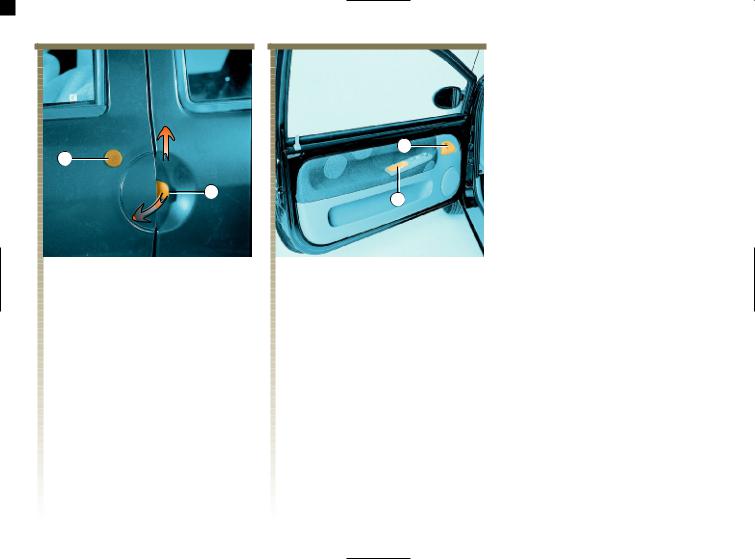
OPENING THE DOORS
3 |
1 |
2 |
4 |
|
Opening the doors from the outside
Use the key to unlock one of the front door locks 1.
Place your hand behind handle 2.
Lift the handle and then pull the door towards you.
Opening the doors from inside the car
Move handle 3.
Pull handle 4 to close the door.
“Lights on” warning buzzer
A warning buzzer will sound on opening a front door if the lights have been left switched on after switching off the ignition (to prevent discharge of the battery).
1.04

LOCKING THE DOORS
1
2
Manual locking
Use the key if outside or press down knob 1 when the door is closed if inside.
Electric central locking
This enables both doors and the luggage compartment to
be locked or unlocked simultaneously.
Press switch 2 to lock or unlock the doors and luggage compartment.
Note: switch 2 is deactivated if the vehicle has been locked with the remote control. The switch becomes operational again after opening a door.
1.05
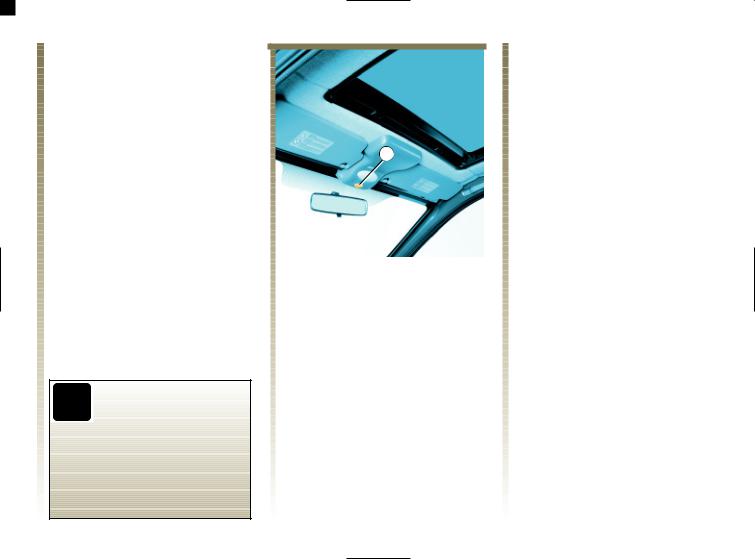
AUTOMATIC DOOR LOCKING WHEN DRIVING
First and foremost, you must decide whether you wish to activate this function.
To activate it
With the ignition on, press central door locking button 1 for about five seconds, until a beep is heard.
To deactivate it
With the ignition on, press central door locking button 1 for about five seconds, until a beep is heard.
If you decide to keep the
doors locked when you
are driving, remember
that it may be more
difficult for those assisting you
to gain access to your vehicle in
the event of an emergency.
1
Operating principle
When the vehicle moves off, the system automatically locks the doors as soon as a speed of 4 mph (6 km/h) is attained.
The door is unlocked
-if a door is opened,
-by pressing door unlocking button 1.
Operating faults
If you note that the system is not operating correctly (automatic locking does not take place), first check that all the doors have been properly closed. If they are closed correctly, consult your Renault Dealer.
Also make sure that locking has not been deactivated inadvertently. If this occurs, switch the ignition off and on again and reactivate it as described above.
1.06

ENGINE IMMOBILISER
This prevents the vehicle being driven by anyone not in possession of the vehicle's coded ignition key.
If the coded ignition key is faulty, use the second key (supplied with the vehicle). If you do not have access to this, it is essential to call a Renault Dealer because only Dealers in the Renault network are qualified to repair the engine immobiliser.
Any work or modification
to the engine immobiliser
(computer, wiring, etc.)
may be dangerous. It must
be carried out by trained Renault
network personnel.
1 |
Operating principle
The vehicle is automatically protected a few seconds after taking the key out of the ignition.
When the ignition is switched on, indicator light 1 comes on for a few seconds and then goes out.
The vehicle has recognised the code and the engine can be started.
If the vehicle does not recognise the ignition key code, indicator light 1 will flash continuously and the engine cannot be started.
 • Indicator light to indicate the
• Indicator light to indicate the
engine immobiliser is operating
When the ignition is switched on, indicator light 1 comes on for approximately three seconds and then goes out. You can then start the engine.
• Vehicle protection indicator light |
A few seconds after the ignition has been switched off, indicator light 1 will flash continuously.
The vehicle will not be protected until the key has been taken out of the ignition.
• Indicator light to indicate that |
the system is not operating |
correctly |
When the ignition has been switched on, if indicator light 1 continues to flash or remains lit continuously, it indicates that the system is not operating correctly.
1.07

ENGINE IMMOBILISER (continued)
Special circumstances
•Starting in very cold weather
(temperature below –20°C)
Switch on the ignition for several seconds before starting the engine to make the engine easier to start.
•If your remote control is faulty, use the second remote control locking device (given to you when the vehicle was delivered).
If you do not have access to this, it is essential to call a Renault Dealer (because only Dealers in the Renault network are qualified to repair the engine immobiliser).
•Make sure that the batteries are always in
good condition - they last for approximately two
years.
Refer to section 5 of the driver's handbook for information on
how to change the batteries.
In the event of the vehicle being equipped with an engine
immobiliser with a remote control.
•If a remote control is replaced, it will be necessary to take the vehicle to your Renault Dealer because both the vehicle and the two remote control units are needed to initialize the system.
1.08

FRONT HEAD RESTRAINT
A
 1
1
To raise or lower the head restraint
Pull the head restraint towards you (i.e. towards the front of the vehicle) and slide it up or down at the same time.
To remove the head restraint
Tilt the seatback towards the rear of the vehicle.
Raise the head restraint until it is at the highest possible setting. Lift up tab 1 and then pull the head restraint upwards until it is released.
To refit the head restraint
Insert the rods into the sleeves with the notches to the front.
Lower the head restraint until it clips into position.
To adjust the angle of the head restraint
On certain vehicles the angle of the head restraint can be adjusted. To do this, move the front section A of the head restraint forwards or backwards until it feels comfortable.
The head restraint is
important for safety. Ensure
that it is in place and in the
correct position. The
distance between your head and
the head restraint should be as
small as possible. The top of the
head should be in line with the top
of the head restraint.
1.09

REAR HEAD RESTRAINT
1
2
To adjust the height
Simply slide it up.
To remove
Press the tab at the back of the head restraint guides.
To refit the head restraint
Insert the rods into the sleeves, with the notches to the front, and lower the head restraint to the desired height.
Storage position 2
When the head restraint is fully lowered, it is in the storage position; do not use this position when someone is sitting in the rear seats.
The |
head |
restraint |
is |
|
important for safety. Ensure |
||||
that it is in place and in the |
||||
correct |
position. |
The |
||
distance between your head and |
||||
the head restraint should be as |
||||
small as possible. The top of the |
||||
head should be in line with the top |
||||
of the head restraint. |
|
|
||
1.10

FRONT SEATS
3
2 |
1 |
To move forwards or backwards
Lift lever 1 to unlock the seat. Release the lever in the required position and ensure the seat is locked in place.
To raise or lower the driver’s seat:
Move lever 2.
To tilt the seatback:
Move lever 3 and tilt the seatback until it is in the required position.
4
Access to the rear seats
Lift door handle 4 and slide the seat forward.
To return the seat to its original (memorised) position on the driver's side, slide the seat backwards until it locks.
So that the effectiveness of the seat belts is not reduced, we would advise you not to recline the
seatbacks excessively.
Make sure the seatback is locked in
place correctly.
No objects should be placed on the
floor (area in front of driver) as
such objects may slide under the
pedal during braking manoeuvres,
thus obstructing its use.
For safety reasons, only
adjust the seats when the
vehicle is stationary.
1.11

SEAT BELTS
Always wear your seat belt when travelling in your car. You must also comply with the local legislation in the particular country you are in.
Before driving off:
- First ensure that your driving position is correct.
- Then adjust your seat belt to provide maximum protection.
Incorrectly adjusted seat
belts may cause injuries
in the event of an
accident.
Even pregnant women should
wear a seat belt. In this case,
ensure that the lap belt is not
exerting too much pressure on
the abdomen but do not allow
any slack.
Adjusting your driving position
•Sit with your back firmly against the seatback.
This is essential to ensure that your lumbar vertebrae are in the correct position.
•Adjust the distance between the seat and the pedals.
Your seat should be as far back as possible for you to be able to fully depress the clutch pedal. The seatback should be adjusted so that your arms are slightly bent when you hold the steering wheel.
•Adjust the position of your head restraint.
For maximum safety your head should be as near as possible to the head restraint.
1
2
3
4
5
Adjusting the seat belts |
Sit with your back firmly against the |
seatback. |
Shoulder strap 1 should be as close |
to the base of the neck as possible |
but not on it. |
Lap strap 2 should be held firmly |
|||
over the thighs and against the |
|||
pelvis. |
|
|
|
The belt should be worn so that it is |
|||
as close to the body as possible, i.e. |
|||
avoid |
wearing |
heavy |
clothing, |
having bulky objects under the belts |
|||
or |
reclining |
the |
seatback |
excessively, etc. |
|
|
|
1.12

SEAT BELTS (continued)
To fasten
Unwind the belt slowly and smoothly and ensure that buckle 3 locks into catch 5. (Check that it is locked by pulling on buckle 3.) If the belt jams, allow it to return slightly before attempting to unwind it again.
If your belt becomes completely jammed:
- Pull the belt slowly but firmly so that just over an inch (3 cm) unwinds.
- Then allow the belt to rewind automatically.
- Unwind it again.
- If the problem persists, consult your Renault Dealer.
To release
Press button 4 on catch 5. The belt will rewind itself.
Hold the buckle to help the operation.
6
1
Adjusting the front seat belt shoulder strap height
Press button 6 to select the position you require so that the shoulder strap 1 is worn as shown above.
When the belt has been adjusted, make sure it is locked in position correctly.
Rear seat belts |
The belts are locked, unlocked and |
adjusted in the same way as the |
front belts. |
Make sure that the rear
seat is locked in position
properly so that the seat
belts will operate
efficiently. Refer to the
information on the rear seat in
section 3.
1.13

METHODS OF RESTRAINT IN ADDITION TO THE FRONT SEAT BELTS
These are:
■Front seat belt pretensioners.
■Force limiter.
■Driver and passenger airbags.
These systems are provided to act independently or together when the vehicle is subjected to a frontal impact.
There are three possibilities, depending on the force of the impact:
-protection is provided by the belt only;
-the pretensioner is triggered to rectify belt position and take up play in the belt;
-if the airbag and force limiter are triggered, they provide additional protection in the event of the most severe impact.
■Side airbags are provided to activate in the event of a severe side impact.
1
Front seat belt pretensioners
This system is only operational when the ignition is switched on.
If the vehicle is subject to a severe frontal impact, piston 1 immediately retracts the seat belt buckle pulling the seat belt tight against the body and thereby improving its efficiency.
• Have the entire restraint system checked following
an accident.
•No work whatsoever may be performed on the pretensioner system (computer, wiring, etc.).
•To avoid incorrect triggering of the system which may cause injury, only qualified RENAULT Network personnel may work on the pretensioner system.
•Testing of the electric trigger system may only be carried out by a specially trained technician using special equipment.
•When scrapping your vehicle, contact your RENAULT Dealer for disposal of the gas generator.
1.14

METHODS OF RESTRAINT IN ADDITION TO THE FRONT SEAT BELTS (continued)
Force limiter
Above a certain severity of impact, this mechanism is used to limit the force of the belt against the body so that it is at an acceptable level.
Driver and passenger airbags
Warning relating to the
service life of airbags
and pretensioners
Pyrotechnic systems for
airbags and pretensioners have a
limited service life: refer to the
servicing booklet for your
vehicle for the replacement
frequency.
An airbag may be provided for both the driver and the front passenger.
Airbag inscriptions on the steering wheel and dashboard together with a label on the lower part of the windscreen indicate that the vehicle is equipped with airbags.
1.15

METHODS OF RESTRAINT IN ADDITION TO THE FRONT SEAT BELTS (continued)
Driver and passenger airbags
(continued)
Each airbag system consists of:
-an airbag and gas generator fitted on the steering wheel for the driver and in the dashboard for the front passenger;
-a computer for both systems, which includes the impact sensor and a monitor controlling the electrical trigger system for the gas generator;
-one single indicator light 1 on the instrument panel.
The airbag system uses the principles of pyrotechnics. This explains why, when the airbag inflates, it will generate heat, produce smoke (this does not mean that a fire is about to start) and make a noise upon detonation. In a situation where an airbag is triggered, it must inflate immediately and this may cause some minor, superficial grazing to the skin.
1 |
Operation
The system is only operational after the ignition has been switched on (ignition key in position M “ignition on”).
If a severe frontal impact occurs, the airbag(s) inflate(s) in approximately 30 milliseconds, cushioning the impact of the driver's head against the steering wheel and the front passenger's head against the dashboard. The airbag then deflates immediately so that the passengers are not impeded in any way when they get out of the vehicle.
Operating faults
Warning light 1 lights up on the instrument panel when the ignition is turned on and then goes out after a few seconds.
If it does not light up when the ignition is turned on or if it flashes, there is a fault in the system.
Consult your RENAULT Dealer as soon as possible. Your protection will be reduced until this problem is rectified.
1.16
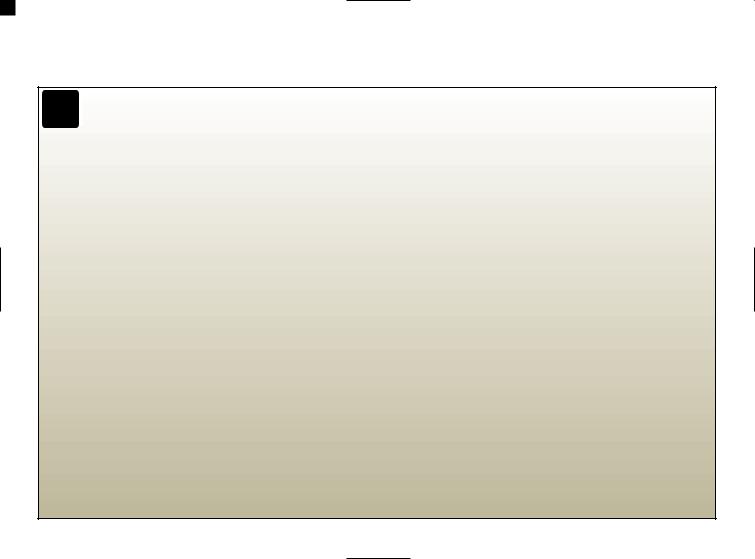
METHODS OF RESTRAINT IN ADDITION TO THE FRONT SEAT BELTS (continued)
All the warnings below are given so that, if the airbag is activated, it is not obstructed in any way and also to prevent the risk of serious injuries caused by items which may be dislodged when the airbag inflates.
The airbag is designed to complement the action of the seat belt. Both the airbags and seat belts are integral parts
of the same protection system. It is therefore essential to wear the seat belt at all times. If seat belts are not worn,
it exposes the occupants to the risk of serious injury in the event of an accident. It may also increase the risk of minor superficial injuries occurring when the airbag is deployed, although such minor injuries are always possible with airbags.
The airbag does not offer protection against minor and moderately serious frontal impacts, side or rear impacts or if the vehicle turns over.
Airbags for driver and passenger
•No work or modification whatsoever may be performed on the entire driver and passenger airbag system (computer, wiring, etc.) except by qualified Renault network personnel.
•To ensure that the system is in good working order and to avoid incorrect triggering of the system which may cause injury, only qualified Renault Network personnel may work on the airbag system.
•As a safety precaution, have the airbag system checked if your vehicle has been involved in an accident, is stolen or broken into.
•When selling or lending the vehicle, inform the user of these points and hand over this handbook with the vehicle.
•When scrapping your vehicle, contact your Renault Dealer for disposal of the gas generator(s).
1.17
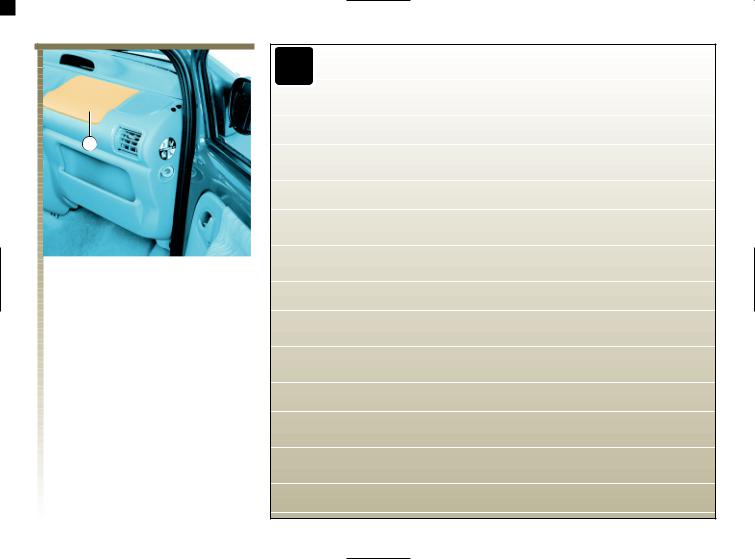
METHODS OF RESTRAINT IN ADDITION TO THE FRONT SEAT BELTS (continued)
1 |
All the warnings below are given so that, if the airbag is activated, it is not obstructed in any way and also to prevent the risk of serious injuries caused by items which may be dislodged when the airbag inflates.
Warnings concerning the driver’s airbag
• Do not modify either the steering wheel or the steering wheel boss.
•Do not cover the steering wheel boss.
•Do not affix any objects (pin, logo, clock, telephone holder, etc.) to the steering wheel boss.
•The steering wheel must not be removed (except by qualified personnel within the Renault network).
•Do not sit too close to the steering wheel. If you sit with your arms slightly bent (see “Adjusting your driving position” in section 1), it will ensure that there is sufficient space for the airbag to inflate properly and to be fully effective.
Warnings concerning the passenger airbag: location 1
•Do not attach or affix with adhesive any objects (pin, logo, clock, telephone support, etc.) on the dashboard near where the airbag is located.
•Do not place anything between the dashboard and the passenger (animal, umbrella, walking stick, parcels, etc.).
•The passenger must not put his or her feet on the dashboard or seat as there is a risk that serious injuries may be sustained. As a general rule, keep all parts of the body (knees, hands, head, etc.) well away from the dashboard.
IT IS FORBIDDEN TO FIT A REAR-FACING CHILD SEAT ON THE FRONT PASSENGER SEAT WHILE THE RESTRAINING METHODS ADDITIONAL TO THE PASSENGER SEAT BELT ARE NOT DEACTIVATED.
(Refer to the information on Deactivation of passenger airbags in Section 1).
1.18

METHODS OF RESTRAINT IN ADDITION TO THE FRONT SEAT BELTS (continued)
1
Airbags
This airbag may be fitted to the front seats and is activated at the sides of the seats (door side) to protect the occupants in the event of a severe side impact.
The markings 1 on the windscreen will remind you of the presence of this equipment.
This system will only operate if a severe side impact occurs.
Warnings concerning the side airbag
• Fitting seat covers: Seats
equipped with an air bag require special covers specifically designed for your
vehicle. Consult your Renault
Dealer to find out if these covers may be purchased from Renault outlets. The use of any covers
other than those designed for
your vehicle (and including those designed for another vehicle) may affect the operation
of these airbags and reduce your
protection.
•Do not place any accessories, objects or even an animal between the seatback and the door. This may prevent the airbag from operating correctly or cause injury if the airbag is deployed.
•No work or modification whatsoever may be performed on the seat except by qualified Renault network personnel.
1.19
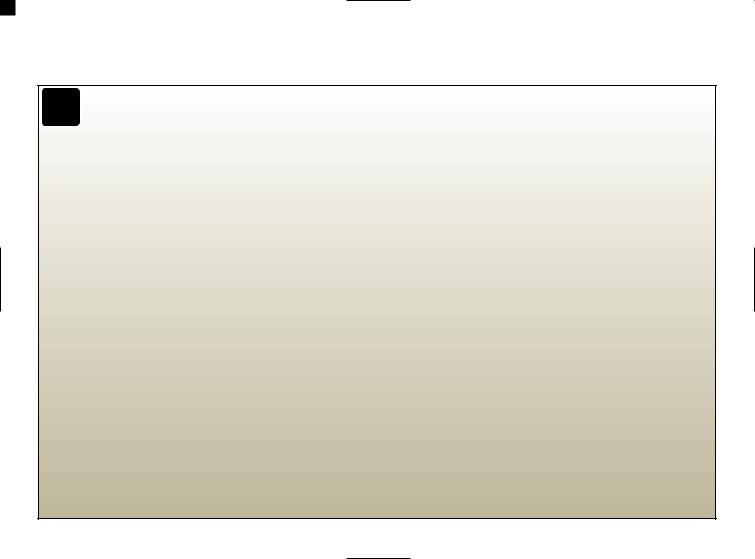
SEAT BELTS
The following information applies to both the vehicle's front and rear seat belts.
• No modification may be made to the component parts of the restraint system (belts and seats and their
mountings) fitted originally.
For special applications (e.g. fitting child seats) consult your Renault Dealer.
•Do not use any devices which give any play in the belts (clothes pegs, clips, for example).
•Never wear the shoulder strap under your arm or behind your back.
•Never use the same belt for more than one person and never hold a baby or child on your knees with your seat belt around them.
•The belt should never be twisted.
•Following a serious accident the seat belts in use at the time must be replaced. Likewise, have your seat belts replaced as soon as they show any signs of wear.
•When refitting the rear bench seat, take care that the seat belts are correctly positioned so that they can be used properly.
•If necessary, re-adjust the position and tension of the belt.
1.20

CHILD SAFETY
Isofix 3-point child seat mounting system
This is a new procedure for installing a child seat. This system equips the front passenger seat and the rear seats of the vehicle.
It consists of the following components:
• Two anchoring rings 1 located between the seat and the seatback;
• an additional anchoring ring (third mounting point);
• A special RENAULT child seat fitted with two latches 3 which hook onto the two rings and an adjustable belt which is attached to the third mounting point ring;
• The seat is fitted with fitting guides 2, which make it easier to fit the seat onto the anchoring rings. These guides have to be fitted onto the anchoring rings (as shown in the illustration opposite).
1
2
 3
3
• Make sure that there is
nothing obstructing the
seat mounting mechanism at the anchorage points
(gravel, rags, toys, etc.).
•Always remember to fasten the seat belts on child seats for all journeys.
When this system is used
on the front passenger seat
it should always be in a rear
facing position and the
passenger airbag must be
deactivated.
Refer to the information on
deactivating the front passenger
airbag.
Only child seats sold by RENAULT are approved for fitting on this vehicle's anchoring rings.
They are fitted with two latches and an adjustable belt which attaches them to the anchoring rings fitted on RENAULT vehicles.
They can also be fitted in other vehicles using a three-point type seat belt.
To purchase these seats, please contact your Renault Dealer.
1.21

CHILD SAFETY (continued)
1
2
 3
3
Fitting a child seat (continued)
•Hook the belt fitted to the child seatback onto the third anchoring point ring (marks 6, 7 or 8);
•Check that the seat is locked correctly by moving it from left to right and then forwards and backwards.
Fitting a child seat
•Before fitting and using the seat, read the instructions provided carefully;
•Attach the fitting guides 2 to the rings 1 fitted to the rear seats and front passenger seat of the vehicle;
•Slide the seat latches 3 into the guides 2 and push the seat hard to lock it onto the rings;
Note: Lashing ring 7 located on the rear roof panel is used for attaching the belt.
If an adult is sitting in a rear seat, the ring, in the event of a severe impact, can cause injuries if kept in the deployed position. For your own safety, we recommend that you return it to its storage position when it is not being used.
The engraved figure on the housing cover reminds you of this precaution.
1.22

CHILD SAFETY (continued)
|
|
|
|
|
|
|
|
A front-facing Isofix seat fitted |
|
7 |
|
|
|
|
|
on the rear seat (continued) |
|
|
|
|
|
|
|
|||
|
4 |
|
|
5 |
|
|
Mounting ring for a front-facing |
|
|
|
|
|
|
|
seat |
||
|
|
|
|
|
|
|
|
|
|
|
|
|
|
|
|
|
Use belt 4 supplied with the seat: |
|
|
|
|
|
|
|
|
- attach hook 5 onto ring 7 (third |
|
|
|
|
|
|
|
|
|
|
|
|
|
|
|
|
|
anchoring point) located on the |
|
|
|
|
|
|
|
|
roof panel rear cross member; |
|
|
|
|
|
|
|
|
- tighten the belt. |
|
|
|
|
|
|
|
|
|
1
4
5 6
A rear-facing Isofix seat fitted on the front passenger seat
The front passenger seat must be adjusted so that the back of the child seat is touching the dashboard.
Use belt 4 supplied with the seat:
-to access the ring, remove cover 6 (third anchoring point);
-attach belt catch 5 to ring 6;
-tighten the belt.
A front-facing Isofix seat fitted on the rear seat
When a front-facing child seat is installed, the front seat must not be moved back beyond the halfway point on the seat runners and the seatback must not be reclined too far.
Each of the rear seats is fitted with two rings for mounting the base of the seat.
1.23

CHILD SAFETY (continued)
A rear-facing Isofix seat fitted on the rear seat (continued)
Use belt 4 supplied with the seat: - attach hook 5 onto ring 8 (third anchoring point) located under
the front passenger seat; - tighten the belt.
4
5
8
A rear-facing Isofix seat fitted on the rear seat
When a rear-facing child seat is installed, the front seat must not be moved forward beyond the halfway point on the seat runners.
The front seat back must be close to or touching the shell of the child seat.
1.24

CHILD SAFETY
In all countries there are regulations governing the use of restraints for children and babies.
In Europe, children under 12 years of age or a height of less than 1.50 m(1) (approx. 5 ft) must travel in an approved seat that is suitable for the height and weight of the child.
The driver is responsible for ensuring that this equipment is used correctly.
Child restraints for which type approval was obtained after January 1992 offer a level of safety much greater than for restraints with type approval before that date.
It is therefore advisable to select a child restraint that complies with European regulation ECE 44.
Restraints that comply with this legislation must be marked with an orange label bearing the letter E followed by a number (which stands for the country where it is type approved) and the year in which the type approval was granted.
(1) You must always comply with the laws of the country in which you are travelling. They may be different to the guidelines in this handbook.
Remember that a collision at 30 mph (50 km/h) is the same as falling a distance of 10 metres. Expressed in other terms, transporting a child without a restraint is the equivalent of allowing him or her to play on a third-floor balcony which does not have any railings.
Under no circumstances
should babies or children
be allowed to travel sitting
on the knees of another
passenger in the vehicle.
If a head-on collision occurs at
30 mph (50 km/h) a child weighing
30 kg (66 lbs) will be transformed
into a missile equivalent to one
tonne: you will find it impossible
to hold the child, even if you
yourself are wearing a belt.
It is particularly dangerous to put
the belt round your child when he
or she is sitting on your knee.
Never use the belt for more than
one person at the same time.
The tables on the following pages |
inform you of the types of child seat |
that can be fitted in each of the |
vehicle seat positions in accordance |
with the European directive. |
Before installing a child seat in the |
front seat (if fitting is permitted) |
If the passenger seat is fitted with |
one, carry out the following |
adjustments: |
- pull back the seat as far as |
possible, |
- straighten the seatback as much as |
possible, |
- raise the seat squab as far as |
possible, |
- pull the headrest up to its |
maximum position, |
- Set the seat belt height control to |
the low position. |
Refer to the Child safety equipment |
booklet available from the Renault |
network to select the seat suited to |
your child and recommended for |
your vehicle. |
1.25
